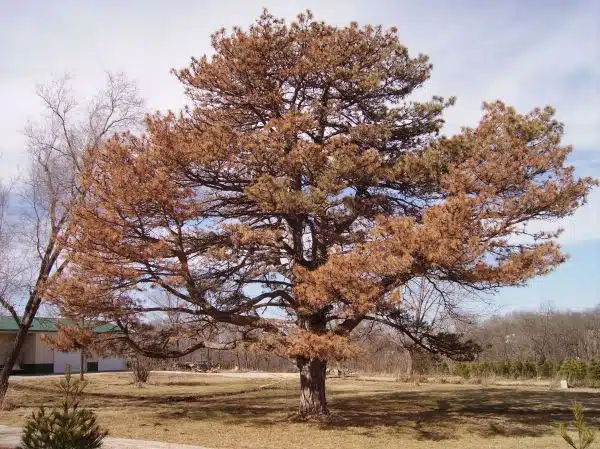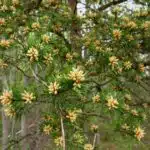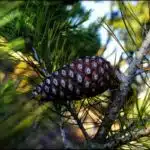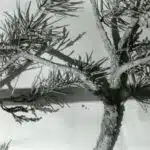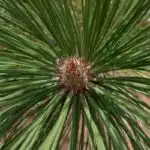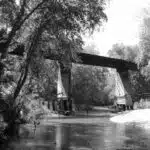As an Austrian Pine expert, I have grown and cared for countless specimens of this beautiful coniferous tree. The Austrian Pine, also known as Pinus nigra, is a hardy and adaptable species that can thrive in a wide range of environments. If you are interested in growing and caring for these trees, there are several factors to consider to ensure their optimal growth and health.
Firstly, it is important to choose the right location for your Austrian Pine. These trees prefer full sun exposure and well-drained soil with a pH level of 6.0-7.5. They can tolerate a variety of soil types, including clay, loam, sand or gravel but require good drainage to avoid waterlogging. Additionally, they are relatively drought tolerant once established but benefit from regular watering during dry periods. By following these guidelines and providing proper care, you can enjoy the beauty and benefits of the Austrian Pine in your landscape for years to come.
Understanding The Austrian Pine’s Characteristics
As an Austrian Pine expert, I have come to appreciate the unique characteristics of this tree species. The Austrian Pine is a hardy evergreen that can withstand harsh environmental conditions, making it an ideal choice for landscaping and gardening enthusiasts. Its needles grow in clusters of two and are dark green in color, giving the tree a distinctive appearance.
When it comes to growing conditions, the Austrian Pine thrives in full sunlight and well-drained soil. This species prefers slightly acidic soil with a pH range between 6.0-6.5. Additionally, they are drought-tolerant once established and can tolerate occasional flooding.
One of the most fascinating characteristics of the Austrian Pine is its ability to adapt to different environments. It can grow in various soil types, including loamy, sandy or clay soils. Moreover, this tree species can tolerate high winds and is resistant to pests and diseases. Understanding these characteristics will help you care for your Austrian Pine effectively as you select the right location for your tree.
Selecting The Right Location For Your Tree
To ensure the successful growth and development of your Austrian pine, it is essential to choose the right location for planting. The first factor to consider is sun exposure. This species thrives in full sun or partial shade, so avoid planting in areas that receive minimal sunlight or are fully shaded. Furthermore, Austrian pines prefer a well-draining soil that does not retain too much moisture.
In addition to sun exposure, soil acidity is also an important consideration. These trees can tolerate a range of pH levels but prefer slightly acidic soil with a pH between 5.0 and 7.5. It is crucial to test the soil before planting to determine if any adjustments are necessary to achieve the ideal pH level for your tree. Soil can be amended with lime or sulfur as needed to reach the desired acidity level.
Selecting the right location for your Austrian pine will provide a foundation for optimal growing conditions and overall health of the tree. Once you have determined an appropriate site based on sun exposure and soil acidity, it’s time to prepare the soil for planting.
Preparing The Soil For Planting
After selecting the perfect location for your Austrian pine tree, it’s time to prepare the soil for planting. As an Austrian pine expert, I cannot stress enough how crucial it is to have healthy and fertile soil for the tree to thrive in. Soil testing is the first step in this process, as it will determine the pH level and nutrient content of your soil.
Once you have received your soil test results, it’s time to make any necessary soil amendments. This may include adding organic matter such as compost or manure, adjusting the pH level with lime or sulfur, and adding essential nutrients such as nitrogen, phosphorus, and potassium. The type and amount of amendments needed will depend on your specific soil composition and the needs of your Austrian pine tree.
Remember that preparing the soil for planting is not a one-time event; ongoing care and maintenance are required to ensure optimal growth and health. Regularly testing the soil every few years and amending as necessary will provide a solid foundation for your Austrian pine tree’s success. With these steps taken care of, you can move on to choosing the best time to plant your tree for maximum benefit.
Soil Amendments Checklist:
- Test soil pH levels
- Determine nutrient deficiencies
- Add organic matter such as compost or manure
- Adjust pH levels with lime or sulfur
Choosing The Best Time To Plant
When it comes to growing and caring for Austrian pine, choosing the best time to plant is crucial to ensure that your tree thrives. The ideal time for planting this type of pine tree is during the fall season, between September and November. This is because the temperature during this season is cool enough to avoid stressing the tree with excessive heat while also allowing the roots to establish before winter.
Before planting your Austrian pine, you should undertake some pre-planting preparations. Start by selecting a location that has well-draining soil, receives sufficient sunlight and has adequate space for the tree’s growth. Once you have identified the perfect spot in your garden or yard, prepare the soil by loosening it up and removing any debris such as rocks, weeds or grass. Mix in some organic matter like compost or peat moss to enhance nutrient uptake by the tree and improve soil structure.
When planting your Austrian pine, it’s essential to use the best planting techniques possible. Start by digging a hole that’s twice as wide but equal in depth to the root ball of your tree. Place some slow-release fertilizer at the bottom of the hole then position your tree so that its roots are facing downwards into the hole. Fill up with soil around the roots while gently tamping down to eliminate any air pockets that could impede growth. After planting, water thoroughly and mulch around the base of your newly planted Austrian pine.
Planting Your Austrian Pine
After choosing the best time to plant your Austrian Pine, it is important to ensure that you are planting at the correct depth. The planting depth for an Austrian Pine should be no deeper than the root ball of the tree itself. Planting too deep can result in poor growth and even death of the tree.
Once you have planted your Austrian Pine, it is important to water it regularly. Newly planted trees require more frequent watering than established ones. Water deeply, but do not let the soil become waterlogged or saturated. This can lead to root rot, which can be fatal for your tree.
In addition to regular watering, fertilizing your Austrian Pine can help promote healthy growth. However, it is important to use a fertilizer specifically formulated for evergreen trees like the Austrian Pine. Follow the instructions on the package carefully and apply at the recommended times throughout the growing season. With proper planting depth, adequate watering, and regular fertilization, your Austrian Pine will thrive for years to come. In order to maintain healthy growth beyond this stage, proper watering and fertilizing techniques must also be applied consistently over time.
Watering And Fertilizing
As an Austrian Pine expert, I know that growing and caring for this tree can be a rewarding experience. However, to ensure its health and longevity, it’s important to understand the proper techniques for watering and fertilizing.
When it comes to watering your Austrian Pine, frequency is key. These trees require regular watering during their first few years of growth, especially in hot or dry climates. After they are established, you can reduce the frequency of watering but still make sure the soil remains moist. It’s important to avoid overwatering as well since this can lead to root rot.
Choosing the right fertilizer is also crucial for maintaining a healthy Austrian Pine. Nitrogen-rich fertilizers are recommended since this element is essential for photosynthesis and growth. When applying fertilizer, make sure to follow the instructions carefully and avoid applying too much since this can damage the roots. A good rule of thumb is to fertilize in early spring before new growth appears and again in late summer or early fall when growth has slowed down.
To keep your Austrian Pine looking its best, pruning and training are necessary techniques that require careful attention.
Pruning And Training Your Tree
Pruning techniques are important for maintaining the shape and health of your Austrian pine tree. The best time to prune is in late winter or early spring, before new growth begins. Start by removing any dead, damaged, or diseased branches with clean pruning shears. Then, thin out crowded areas to allow more sunlight and air circulation to reach the interior branches.
Training methods can also be used to shape your tree as it grows. One common method is called central leader training, where you choose one main trunk and remove any competing leaders. This encourages a straight, upright growth pattern. Another method is called multi-leader training, where you allow multiple trunks to grow from the base of the tree. This creates a fuller, bushier appearance.
Remember to always use proper pruning tools and techniques to avoid damaging your tree. Regular maintenance will help keep your Austrian pine healthy and attractive for years to come.
Moving on to preventing and managing pests and diseases…
Preventing And Managing Pests And Diseases
As an Austrian pine expert, I understand the importance of preventing and managing pests and diseases to ensure the tree’s overall health. Integrated pest and disease management is an effective approach that involves combining various control strategies to manage pests and diseases effectively. This approach includes cultural practices, such as maintaining good soil drainage, sanitation, pruning, and monitoring for pests and diseases.
Cultural practices play a vital role in preventing pests and diseases from infesting Austrian pines. Maintaining good soil drainage is crucial in keeping roots healthy, which helps to prevent root rot caused by fungi. Sanitation involves removing any infected or dead branches from the tree before they spread the disease further. Pruning also helps to remove damaged or diseased branches while improving air circulation around the tree, which reduces pest infestations.
Monitoring for pest infestations is critical in preventing significant damage to Austrian pines. Early detection of pests such as spider mites, sawflies, scale insects, and adelgids can help reduce their numbers before they cause severe damage. Integrated pest management strategies such as using natural predators like ladybugs can be effective at controlling pest populations without harming beneficial insects.
Maintaining good soil drainage is essential for the overall health of your Austrian pine tree. In the next section, we will discuss ways of ensuring proper soil drainage that will keep your tree healthy and free from disease and pests.
Maintaining Good Soil Drainage
To ensure the health of your Austrian Pine, it is important to maintain good soil drainage. Poorly drained soil can lead to root rot and other fungal diseases that can be fatal to your tree if left unchecked. Improving drainage can be done through a variety of methods, including amending the soil and creating drainage channels.
One way to improve drainage is by adding soil amendments. Adding organic matter, such as compost or well-rotted manure, can help improve water retention in sandy soils and increase drainage in clay soils. Additionally, incorporating perlite or vermiculite into the soil mixture can help with both water retention and drainage.
Another method for improving drainage is by creating drainage channels around the base of the tree. These channels allow excess water to flow away from the tree’s roots and prevent standing water from accumulating. This can be especially important during heavy rainfall periods when excess water can drown your tree’s roots.
Incorporating these methods for improving soil drainage will go a long way in ensuring the health and longevity of your Austrian Pine. However, there are still more steps you can take to optimize its growth potential. Mulching is an effective technique that not only helps with moisture control but also suppresses weeds and moderates temperature fluctuations in the soil. Read on for tips on how to mulch your Austrian Pine for optimal growth.
Mulching For Optimal Growth
There is a theory that mulching can help Austrian Pine grow faster and healthier. This theory is backed by scientific research indicating the benefits of mulching. Mulch is a layer of organic materials, such as wood chips or leaves, spread on top of the soil around the tree’s base. Mulch helps to maintain soil moisture, reduce weed growth, and regulate soil temperature.
The benefits of mulching are numerous when it comes to growing Austrian Pine. Firstly, it conserves moisture in the soil which is essential for maintaining an optimal water balance in trees. Secondly, mulch provides insulation to the root zone which helps to regulate soil temperature fluctuations that can damage roots. Thirdly, mulch suppresses weeds that compete with roots for nutrients and water.
When it comes to choosing the right type of mulch for your Austrian Pine tree, there are several options available. Organic mulches like wood chips, grass clippings or leaves are ideal because they break down slowly over time and release nutrients back into the soil. Inorganic options like gravel or stones are also useful but not as effective as organic ones in terms of improving soil quality. Ultimately, any type of mulch will provide some benefit so choose one that suits your needs and budget.
Protecting your tree from harsh weather is crucial in ensuring its optimal growth and health. To do this effectively requires careful consideration of factors such as location and proximity to other trees or buildings. In our next section, we will discuss how you can protect your Austrian Pine from harsh weather conditions using simple yet effective strategies that don’t require much effort or expertise on your part.
Protecting Your Tree From Harsh Weather
Watering is an essential part of caring for an Austrian pine in harsh weather conditions, as it helps prevent it from wilting and becoming stressed. Mulching is also advantageous, as it helps to retain soil moisture and provide insulation to the tree. Pruning can also be beneficial for an Austrian pine in harsh weather, as it helps to keep the tree healthy and reduce wind damage. Windbreaks such as fencing and vegetation can also be used to help protect an Austrian pine from harsh weather conditions.
Watering
Maintaining proper watering frequency is crucial for the health and growth of your Austrian pine tree. As an Austrian pine expert, I recommend monitoring soil moisture levels regularly to determine when it’s time to water your tree. The frequency of watering largely depends on the weather conditions and soil type.
If you’re experiencing high temperatures or drought, you may need to water your Austrian pine more frequently than usual to prevent stress and damage. On the other hand, overwatering can lead to root rot and suffocation, which can harm or even kill your tree. To avoid these issues, it’s essential to strike a balance between providing enough water for your tree’s needs without drowning it.
In summary, keeping an eye on soil moisture levels is key when it comes to watering your Austrian pine. By understanding the specific needs of your tree and adjusting watering frequency accordingly, you can ensure that it thrives in any weather conditions. Remember to avoid overwatering or underwatering and aim for consistency in providing just the right amount of water for optimal growth and health.
Mulching
As an Austrian pine expert, protecting your tree from harsh weather is a crucial aspect of maintaining its health and beauty. One way to do this is through mulching, which can provide numerous benefits for your tree. Mulch helps retain soil moisture, regulate soil temperature, and suppress weed growth, all of which contribute to the overall well-being of your Austrian pine.
When it comes to choosing the right type of mulch for your tree, there are several options available. Organic mulches such as wood chips or shredded leaves are great choices as they slowly release nutrients into the soil as they decompose. Inorganic mulches like gravel or rocks also work well in preventing weed growth while allowing water to penetrate the soil. However, it’s important to avoid using thick layers of mulch that can suffocate the roots and cause damage.
Applying a layer of two to three inches of mulch around the base of your Austrian pine can help protect it from harsh weather conditions such as extreme heat or cold. Additionally, it can improve soil quality and promote healthy root growth. As with any aspect of tree care, proper research and attention to detail are essential when it comes to selecting and applying mulch for your Austrian pine. By taking these steps, you can ensure that your tree thrives in any weather condition while enhancing its natural beauty.
Monitoring Growth And Health
After protecting your Austrian pine tree from harsh weather, it’s time to monitor its growth and health. Measuring progress is essential in determining the success of nurturing and caring for your tree. The following techniques will help you keep track of your tree’s development:
- Use a measuring tape to measure the height of the tree annually.
- Monitor the growth of branches by observing how far they extend from the trunk each year.
- Check for any signs of discoloration or wilting leaves.
- Evaluate the overall appearance of the tree, including its shape and fullness.
Disease prevention techniques are also crucial in maintaining a healthy Austrian pine tree. Prevention is always better than cure, so it’s best to take preventive measures before diseases occur. Here are some helpful tips:
- Apply fungicides regularly during wet seasons to prevent fungal infections.
- Prune diseased branches immediately to prevent further spread.
- Keep an eye out for pests such as aphids and spider mites that can damage the tree.
- Regularly fertilize your tree with nitrogen-rich fertilizer to strengthen its immunity against diseases.
Monitoring growth and preventing diseases may seem like a daunting task, but applying these techniques will ensure that your Austrian pine grows into a healthy and beautiful specimen in no time.
As you continue to care for your Austrian pine, there comes a point where you may want to harvest pine cones and needles for various uses such as crafts or mulching material for other plants in your garden. Proper harvesting techniques are important to avoid damaging the tree while collecting its cones and needles – we’ll cover this topic in the next section.
Harvesting Pine Cones And Needles
As the saying goes, “Patience is bitter, but its fruit is sweet.” This adage rings true for those looking to harvest pine cones and needles from their Austrian pine. It takes time and care to properly collect these materials without damaging the tree or hindering future growth.
When collecting pine cones, it’s important to wait until they are fully matured and have opened on their own. This ensures that the seeds inside are viable for planting or crafting decorations. To collect them, gently twist or shake the cone, allowing the seeds to fall into a container or onto a tarp below.
Similarly, when harvesting needles for use in teas or roasting pine nuts, it’s crucial not to remove too many from one branch or area. Doing so can harm the tree and stunt its growth. Instead, carefully pluck needles from various parts of the tree to spread out the impact. With proper care and patience in harvesting these materials, Austrian pines can provide a plethora of resources for both crafting and culinary purposes.
| Pine Cone Crafts | Pine Needle Uses |
|---|---|
| Wreaths | Tea |
| Ornaments | Potpourri |
| Fire Starters | Sachets |
| Bird Feeders | Roasting Pine Nuts |
| Centerpieces | Aromatherapy |
Looking beyond just harvesting pine cones and needles, Austrian pines have a variety of uses in landscaping and woodworking as well. Their sturdy wood can be used for furniture making, while their unique shape and texture make them a popular choice for ornamental trees in landscaping designs. As with any resource provided by nature, it’s important to approach harvesting with respect and care to ensure that these trees continue to thrive for years to come.
Using Austrian Pine For Landscaping And Woodworking
Harvesting pine cones and needles is a crucial step in the care and maintenance of Austrian Pine. Once these are harvested, it is time to move onto using Austrian Pine for landscaping and DIY woodworking projects. Known for its hardiness and durability, this type of pine can be used in a variety of ways to enhance the aesthetic appeal of any outdoor space.
Landscaping ideas that incorporate Austrian Pine include adding it as a centerpiece in a rock garden or planting a row of them along a fence line. They can also be used as windbreaks or privacy screens due to their dense foliage. For those looking for more unique designs, shaping Austrian Pine into topiary shapes or creating living walls with them are also great options.
When it comes to DIY woodworking projects, Austrian Pine is ideal for building outdoor furniture such as picnic tables or benches. Its strength and resistance to decay make it perfect for withstanding the elements. It can also be used to construct birdhouses or other small decorative items that add rustic charm to any space.
Moving forward, those who encounter problems with their Austrian Pine should not fret. In the next section, we will discuss some common issues that may arise when caring for this type of tree and offer solutions on how to resolve them effectively.
Troubleshooting Common Problems
Common pests and fungal infections can pose a threat to the growth and health of Austrian pine trees. Pests such as spider mites, sawflies, and bark beetles can damage the tree’s needles and bark, while fungal infections like Diplodia tip blight can cause tip dieback and discoloration. To prevent these issues, it is important to maintain proper tree hygiene by removing dead or diseased branches promptly.
If you notice any signs of infestation or infection, it is crucial to take action immediately. This may involve applying systemic insecticides or fungicides, pruning affected areas, or even removing heavily infested trees altogether. It is recommended to consult with a professional arborist for the best course of action based on your specific situation.
Prevention is key when it comes to common pests and fungal infections in Austrian pine trees. Regular inspections can help detect early signs of issues before they become severe. Additionally, providing adequate sunlight, water, and nutrients can help keep the tree healthy and better equipped to defend against potential threats. By staying vigilant and taking proactive measures, you can ensure that your Austrian pine thrives for years to come without succumbing to common problems.
Conclusion
The Austrian Pine is a hardy, long-lived tree that can provide beauty and shade to any landscape. As an Austrian Pine expert, understanding the characteristics of this species is crucial for successful growth and care. When selecting a location for your tree, consider factors such as sunlight exposure and soil quality. Preparing the soil before planting is also essential in ensuring healthy growth.
Planting at the appropriate time, usually in early spring or late fall, will give your sapling the best chance at survival. Monitoring the growth and health of your Austrian Pine through regular watering, fertilization, and pruning is vital to maintaining its strength and longevity. Harvesting pine cones and needles can also be beneficial for landscaping or woodworking projects.
One interesting statistic about the Austrian Pine is that it has been known to live up to 500 years in some cases. This fact alone highlights the importance of proper care and maintenance throughout its lifespan. As an expert in this field, I highly recommend taking the necessary steps to ensure the long-term health and beauty of your Austrian Pine tree. By following these guidelines, you can enjoy this magnificent species for generations to come.
Image Credits
- “File:Big Austrian pine with pine wilt.jpg” by Mateinsixtynine (featured)

